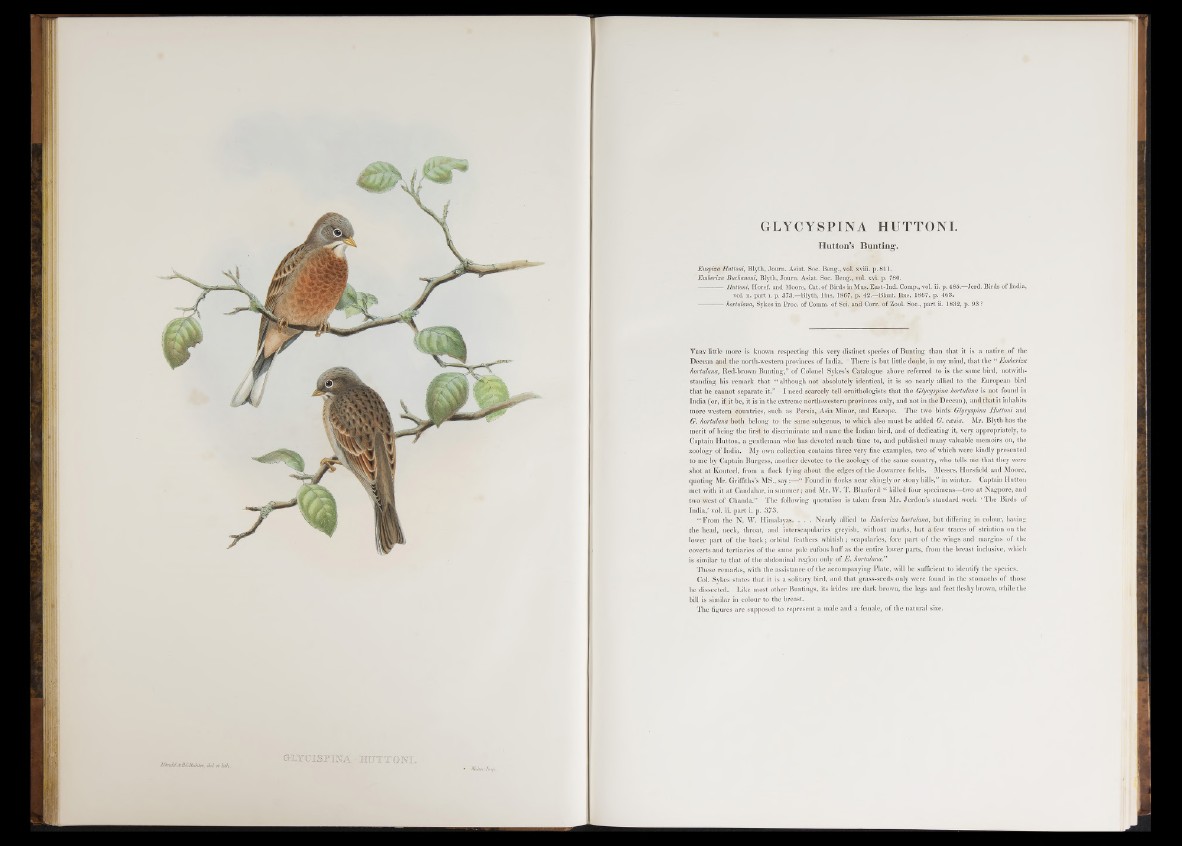
J.Gmüxb&EGItickter, del et lith & IXCISP IHÄ. ■ H U T T O K I.
WdherJmp.
GLYCYSPINA HUTTONI.
Hutton’s Bunting1.
Euspiza Huttoni, Blyth, Joürn. Asiat. Soc. Beng., vol, xviii. p. 811.
Emberiza Buchanani, Blyth, Joum. Asiat. Soc. Beng.,, vol. x v i.p . 780.
------------ Huttoni, Horsf. and Moore, Cat. of B irds in Mus, E ast-Ind. Comp., vol. ii. p. 485.—Jerd. Birds o f India,
vol. ii. p a rt i. p. 373.—Blyth, Ibis, 1867, p . 42.— Blanf. Ibis, 1867, p. 463.
------------ hortulana, Sykes in Proc. o f Comm, o f Sei. and C orr. o f Zool. Soc., p a r t ii. 1832, p. 93 ?
V e r y little more is known respecting this very distinct species of Bunting than that it is a native of the
Deccan and the north-western provinces of India. ’ There is but little doubt, in my mind, that the “ Emberiza
hortulana, Red-brown Bunting,” of Colonel Sykes’s Catalogue above referred to is the same bird, notwithstanding
his remark that “ although not absolutely identical, it is so nearly allied to the European bird
that he cannot separate it.” • I need scarcely tell ornithologists that the Glycyspina hortulana is not found in
India £pr, if it be, it is in the extreme north-western provinces only, and not in the Deccan), and that it inhabits
more western countries, such as Persia, Asia Minor, and Europe. The two birds Glycyspina Huttoni and
G. hortulana both belong to the same subgenus, to which also must be added G. cæsia. Mr. Blyth has the
merit of being the first to discriminate and name the Indian bird, and of dedicating it, very appropriately, to
Captain Hutton, a gentleman who has devoted much time to, and published many valuable memoirs on, the
zoology o f India. My own collection contains three very fine examples, two of which were kindly presented
to me by Captain Burgess, another devotee to the zoology of the same country, who tells me that they were
shot a t Kouteel, from a flock flying about the edges of the Jowarree fields. Messrs. Horsfield and Moore,
quoting Mr. Griffiths’s MS., say :— “ Found in flocks near shingly or stony hills,” in winter. Captain Hutton
met with it a t Candahar, in summer ; and Mr. W . T. Blanford “ killed four specimens—two at Nagpore, and
two west of Chanda.” The following quotation is taken from Mr. Jerdon’s standard work ‘ The Birds of
India,’ vol. ii. part i. p. 373.
“ From the N. W. Himalayas. . . . Nearly allied to Emberiza hortulana, but differing in colour, having
the head, neck, throat, and interscapularies greyish, without marks, but a few traces of striation on the
lower part of the back ; orbital feathers whitish ; scapularies, fore part of the wings and margins of the
coverts and tertiaries of the same pale rufous buff as the entire lower parts, from the breast inclusive, which
is similar to that of the abdominal region only of E . hortulana.”
These remarks, with the assistance of the accompanying Plate, will be sufficient to identify the species.
Col. Svkes states that it is a solitary bird, and that grass-seeds only were found in the stomachs of those
he dissected. Like most other Buntings, its irides are dark brown, the legs and feet fleshy brown, while the
bill is similar in colour to the breast.
The figures are supposed to represent a male and a female, of the natural size.